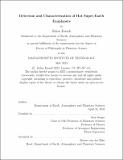Detection and Characterization of Hot Super-Earth Exoplanets
Author(s)
Essack, Zahra
DownloadThesis PDF (13.61Mb)
Advisor
Seager, Sara
Terms of use
Metadata
Show full item recordAbstract
Hot super-Earths are exoplanets characterized by short orbital periods and surface temperatures high enough to melt silicate rock. These planets lack any solar system analog, and are the most accessible small, rocky exoplanets available to study today. In this thesis, I develop a holistic understanding of hot super-Earth exoplanets through laboratory experiments, modeling, and telescope observations, with a focus on three main research areas: surface characterization, atmospheric characterization, and planet detection.
Surface characterization is explored through laboratory experiments to help explain the observed brightness (high geometric albedos) of some hot super-Earths. We design high-temperature experiments to create and measure the reflectivity of lava and quenched glasses, and find that these surface materials have low albedos. This implies that the high albedos of some hot super-Earths are likely a result of a highly reflective atmosphere or an evolved high-albedo surface, allowing us to constrain the parameter space of possible reflected light sources.
Atmospheric characterization is explored through modeling of planetary atmospheric escape and transmission spectra, to determine detectable observational signatures that can be used to probe the composition and evolution of rocky vapor atmospheres around hot super-Earths. We find that ground-based high-resolution spectrographs have the best capabilities for detecting the sodium resonance doublet absorption feature in transmission spectra of a sample of hot super-Earths. We identify K2-141 b as the best planetary target for future sodium observations, and constrain the currently available target list for validating models of the surface and atmospheric evolution of highly irradiated rocky planets.
Finally, the planet detection component of the thesis uses photometric data, and precise radial velocity measurements to discover, and measure the mass of the exoplanet TOI-1075 b, one of the most massive super-Earths discovered to date. The composition and bulk density of TOI-1075 b suggest that the planet has no substantial atmosphere, despite its mass and size, challenging existing theories on planetary atmospheric evolution. Studying the TOI-1075 system in the broader context of short-period planetary systems is necessary for testing planet formation and evolution theories, density-enhancing mechanisms, and for future surface and atmospheric characterization studies of the planet via emission spectroscopy.
Date issued
2023-06Department
Massachusetts Institute of Technology. Department of Earth, Atmospheric, and Planetary SciencesPublisher
Massachusetts Institute of Technology